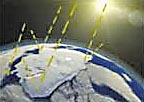

Perennial sea ice could be gone by the end of this century
A National Aeronautics and Space Administration (NASA) study finds that perennial sea ice in the Arctic is melting faster than previously thought - at a rate of 9 percent per decade. If these melting rates continue for a few more decades, the perennial sea ice will likely disappear entirely within this century, due to rising temperatures and interactions between ice, ocean and the atmosphere that accelerate the melting process.Perennial sea ice floats in the polar oceans and remains at the end of the summer, when the ice cover is at its minimum and seasonal sea ice has melted. This year-round ice averages about 10 feet in depth, but can be as thick as 20 feet or more.
The study also finds that temperatures in the Arctic are increasing at the rate of 2.2 degrees F per decade. Melting sea ice would not affect sea levels, but it could profoundly impact summer shipping lanes, plankton blooms, ocean circulation systems and global climate. "If the perennial ice cover, which consists mainly of thick multi-year ice floes, disappears, the entire Arctic Ocean climate and ecology would become very different," says Josefino Comiso, a researcher at NASA's Goddard Space Flight Center, Greenbelt, who authored the study.
Comiso used satellite data to track trends in minimum Arctic sea ice cover and temperature over the Arctic from 1978 to 2000. Since sea ice does not change uniformly in terms of time or space, Comiso sectioned off portions of the Arctic data and carefully analyzed these sections to determine when ice had reached the minimum for that area each year. The results were compiled to obtain overall annual values of perennial sea ice. Prior to the complete data provided by satellites, most records came from sparsely located ocean buoys, weather stations and research vessels.
The rate of decline is expected to accelerate due to positive feedback systems between the ice, oceans and atmosphere. As temperatures in the Arctic rise, the summer ice cover retreats, more solar heat gets absorbed by the ocean, and more ice gets melted by a warmer upper water layer. Warmer water may delay freezing in the fall, leading to a thinner ice cover in the winter and spring, which makes the sea ice more vulnerable to melting in the subsequent summer. Also, the rise in summer ice temperatures by about 2.2 degrees F each decade could lengthen the summers, allowing earlier spring thaws and later freeze dates in the fall, causing further thinning and retreat of perennial ice.
Comparing the differences between Arctic sea ice data from 1979 to 1989 and data from 1990 to 2000, Comiso found the biggest melting occurred in the western area (Beaufort and Chukchi Seas) while considerable losses were also apparent in the eastern region (Siberian, Laptev and Kara Seas). Also, perennial ice actually advanced in relatively small areas near Greenland.
In the short term, reduced ice cover would open shipping lanes through the Arctic. And massive melts could increase biological productivity, since melt water floats and provides a stable layer conducive to plankton blooms. Also, both regional and global climates would be impacted, since summer sea ice currently reflects sunlight out to space, cooling the planet's surface and warming the atmosphere.
Report Abusive Comment